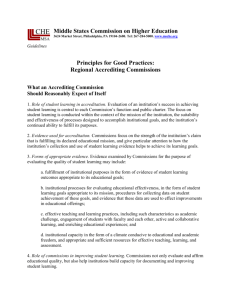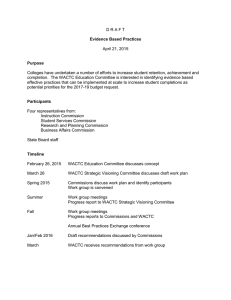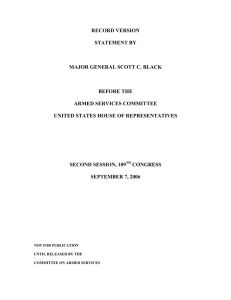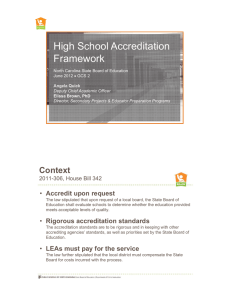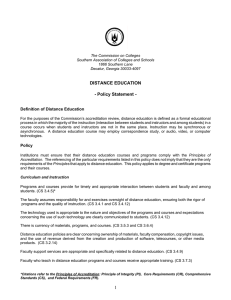Regional Accreditation
advertisement
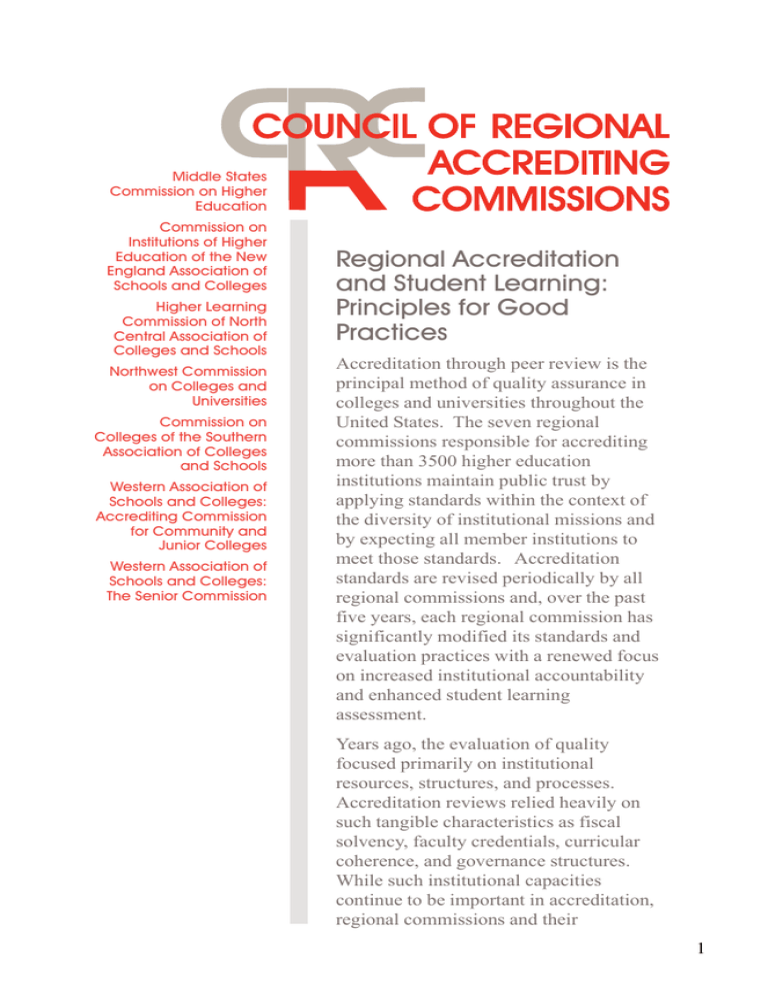
Middle States Commission on Higher Education Commission on Institutions of Higher Education of the New England Association of Schools and Colleges Higher Learning Commission of North Central Association of Colleges and Schools Northwest Commission on Colleges and Universities Commission on Colleges of the Southern Association of Colleges and Schools Western Association of Schools and Colleges: Accrediting Commission for Community and Junior Colleges Western Association of Schools and Colleges: The Senior Commission Regional Accreditation and Student Learning: Principles for Good Practices Accreditation through peer review is the principal method of quality assurance in colleges and universities throughout the United States. The seven regional commissions responsible for accrediting more than 3500 higher education institutions maintain public trust by applying standards within the context of the diversity of institutional missions and by expecting all member institutions to meet those standards. Accreditation standards are revised periodically by all regional commissions and, over the past five years, each regional commission has significantly modified its standards and evaluation practices with a renewed focus on increased institutional accountability and enhanced student learning assessment. Years ago, the evaluation of quality focused primarily on institutional resources, structures, and processes. Accreditation reviews relied heavily on such tangible characteristics as fiscal solvency, faculty credentials, curricular coherence, and governance structures. While such institutional capacities continue to be important in accreditation, regional commissions and their 1 constituencies now recognize that “capacity” alone is not sufficient for demonstrating institutional effectiveness. Through the application of assessment and effectiveness standards developed over a decade ago, the experience of institutions and accreditors has progressed significantly while dealing with the complex set of issues related to assessment and student learning. Based on this increased experience and in response to heightened public attention to issues of educational effectiveness, accrediting commissions have revised their standards and evaluation processes to make the focus on student learning outcomes central to the accreditation review process. At the core of these new approaches are such questions as: What are students learning? Is it the right kind of learning? What difference is the institution making in their lives? What evidence does an institution have that ensures it is worth the student’s investment? The diversity of America’s colleges and universities provides public access to higher education unequalled anywhere in the world. While increasing its focus on student learning, regional accreditation has worked to balance respect for the diversity of its higher education institutions with the consistent application of accountability standards. Thus, commissions have largely avoided dictating the learning outcomes of individual institutions. Instead of insisting on compliance to standardized learning goals, they have promulgated standards that not only assess institutional capacity, but also evaluate the congruence between an institution’s mission and its learning goals, curricular 2 offerings, and student learning outcomes. Accrediting commissions also require institutions to use student learning data to enhance organizational self-reflection and to show how they have used these data to improve their educational programs. In essence, institutions are expected to be clear about their mission and educational purposes and to demonstrate, through their educational goals and results, how well these purposes are being accomplished. In this way, accreditation is able to focus on the quality of student learning without specifying what that learning should be – in short, to promote standards without standardization. Beginning in 2001, the Council of Regional Accrediting Commissions (C-RAC), a confederation of all seven regional accrediting commissions’ executive directors and commission chairs, undertook a study of each commission’s standards and practices dealing with student learning and academic achievement. Findings from the study indicated significant changes in the focus given to student learning and in the approaches and issues addressed by each of the commissions. Consequently, C-RAC developed two sets of Principles to inform and guide policy and practice with respect to student learning in the accreditation review process. One set of Principles deals with what each regional accrediting commission should reasonably expect of itself; the other addresses what an accrediting commission should reasonably expect of its institutional members. These two sets of Principles are presented in the pages that follow. The Principles are important for several reasons: First, as core values, they exist to help guide the work of all regional commissions. They are intended both as a framework upon which to build policies and practices and as a collective vision to which regional commissions and their member institutions should aspire. Second, they demonstrate the commissions’ shared commitment to student learning, and thus are not intended to supplant the standards of individual commissions in any way. The Principles do not conflict with existing standards; they highlight and complement them. Third, the Principles provide a basis for assessing accreditation practice across the regions. They make available, for the first time, a national benchmark for individual commissions, one that will not only promote the importance of student learning to member institutions, but also help commissions evaluate their own work. Support for this document was provided in part by a grant from The Pew Charitable Trusts Principles for Good Practices I. What an accrediting commission should reasonably expect of an institution: 1. The centrality of student learning in its mission. The institution defines educational quality—one of its core purposes—by how well it fulfills its declared mission on student learning. 2. Documentation of student learning. The institution demonstrates that student learning is appropriate for the certificate or degree awarded and is consistent with the institution’s own standards of academic performance. The institution accomplishes this by: a. setting clear learning goal, that speak to both content and level of attainment; b. collecting evidence of goal attainment using appropriate assessment tools; c. applying collective judgment as to the meaning and utility of the evidence; and d. using this evidence to improve its programs. 3. Compilation of evidence. The institution derives evidence of student learning from multiple sources, such as courses, curricula, and co-curricular programming, and includes effects of both intentional and unintentional learning experiences. Evidence collected from these sources is complementary and demonstrates the impact of the institution on the student. 4. Stakeholder involvement. The collection, interpretation, and use of student learning evidence is a collective endeavor, and is not viewed as the sole responsibility of a single office or position. Those in the institution with a stake in decisions of 3 educational quality should participate in the process. 5. Capacity building. The institution uses broad participation to reflect upon student learning outcomes as a means of building a commitment to educational improvement. II. What an accrediting commission should reasonably expect of itself: 1. The centrality of student learning in accreditation. Evaluation of an institution’s success in achieving student learning is central to each commission’s function and public charter. The review of student learning is conducted within the context of the mission of the institution and is based on the suitability and effectiveness of processes designed to accomplish institutional goals and on the institution’s continued ability to fulfill its purposes. 2. Evidence of student learning for accreditation. Commissions focus on the strength of the institution’s claim that it is fulfilling its declared educational mission and give particular attention to how the institution’s collection and use of student learning evidence helps to achieve its learning goals. 3. Forms of appropriate evidence. Evidence examined by commissions to evaluate the quality of student learning may include: a. fulfillment of institutional purposes (in the form of evidence of student learning 4 outcomes appropriate to educational goals); b. institutional processes for evaluating educational effectiveness (in the form of student learning goals appropriate to mission, procedures for collecting data on student achievement, and evidence that these data are used to improve educational offerings); c. effective teaching and learning practices (in the form of academic challenge, engagement of students with faculty and each other, active and collaborative learning, and other enriching educational experiences); and d. institutional capacity (in the form of a climate conducive to educational and academic freedom, and appropriate and sufficient resources for effective teaching, learning, and assessment). 4. The improvement of student learning through accreditation. Commissions not only evaluate and affirm educational quality but also help institutions document and improve student learning. 5. Training. Commissions train evaluation teams, commissioners, and staff in the skills needed for effective accreditation practice, and operate within the spirit expressed by these Principles. — Adopted by the Council of Regional Accrediting Commissions, 2003.
